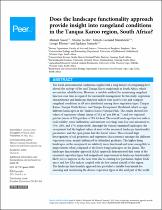| dc.contributor.author | Saaed, Manam | |
| dc.contributor.author | Jacobs, Shayne | |
| dc.contributor.author | Samuels, Igshaan | |
| dc.date.accessioned | 2022-07-12T09:00:37Z | |
| dc.date.available | 2022-07-12T09:00:37Z | |
| dc.date.issued | 2022 | |
| dc.identifier.citation | Saaed, M. et al. (2022). Does the landscape functionality approach provide insight into rangeland conditions in the Tanqua Karoo region, South Africa?. PeerJ, 10, e13305. https://doi.org/10.7717/peerj.13305 | en_US |
| dc.identifier.issn | 2167-8359 | |
| dc.identifier.uri | https://doi.org/10.7717/peerj.13305 | |
| dc.identifier.uri | http://hdl.handle.net/10566/7590 | |
| dc.description.abstract | The harsh environmental conditions coupled with a long history of overgrazing have
altered the ecology of the arid Tanqua Karoo rangelands in South Africa, which
necessitates rehabilitation. However, a suitable method for monitoring rangeland
function over time is required for sustainable management. In this study, vegetation
characteristics and landscape function indices were used to rate and compare
rangeland conditions in 43 sites distributed among three vegetation types: Tanqua
Karoo, Tanqua Wash Riviere, and Tanqua Escarpment Shrubland, which occupy
different landscapes in the Tankwa Karoo National Park. The results showed low
values of vegetation volume (mean of 10.1 m3 per 100 m−2
) and low vegetated
patches (mean of 29% patches vs 71% fetches). The overall landscape function indices
(soil stability, water infiltration, and nutrient recycling) were low and amounted to
55%, 28%, and 17%, respectively. | en_US |
| dc.language.iso | en | en_US |
| dc.publisher | PeerJ | en_US |
| dc.subject | Conservation Biology | en_US |
| dc.subject | Ecology | en_US |
| dc.subject | Ecosystem Science | en_US |
| dc.subject | Soil Science | en_US |
| dc.subject | Natural Resource Management | en_US |
| dc.title | Does the landscape functionality approach provide insight into rangeland conditions in the Tanqua Karoo region, South Africa? | en_US |
| dc.type | Article | en_US |

